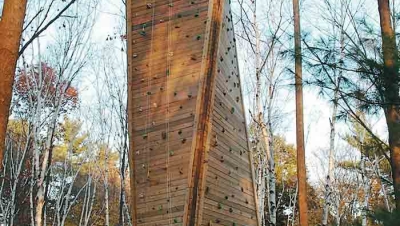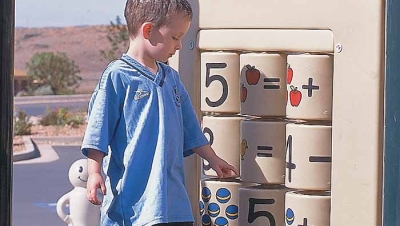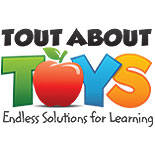Many children who are at risk come into recreation and education programs with environmental conditioning that has them believing they are “damaged goods.” These children may be routinely hit and told they are worthless. Other children in your care, while not physically abused, are submitted to emotional and verbal cruelty. They are the butts of jokes; they are bullied, and they are targets of yelling and cursing. Then there are those who are living with abandonment by family members, hunger and language barriers. When you look at children whose young lives are so difficult, you see them begging to be saved from the callousness of life.
Nancy McClellan, who coordinates the literacy program for the inner city Bethlehem Center in Nashville, Tenn, is quick to acknowledge that many children have rough lives. She is frequently consulted about program development for children who are at risk. McClellan has developed the following motto:
“Be consistent. Be firm. Be kind. Many children ‘run wild,’ with little effective parenting in their lives. They want you to set the boundaries and to help them learn self-control. By establishing consistent expectations of behavior, children learn they can depend on you for guidance. When children lose control, help them figure out why they are being disciplined, and help them to verbalize and to demonstrate in front of you what they are expected to do. If another person is involved, supply the perpetrator with words that express empathy. Then heap on praise.”
McClellan, who also facilitates parents programs, notes that many parents do not know what to do once the glamour of pregnancy wears off. “Women, especially young women, are shocked to realize the amount of work child-rearing takes and how much drudgery is involved. Many parents lack maturity, and many have no support from family or friends.”
With McClellan’s encouragement, the following ideas may be helpful in creating strong programs for children whose lives can be dramatically changed by adults’ caring and expertise.
Background Checks: Employees set the bar for appropriate adult behavior. Make certain that employees have no felony convictions, and if they have an arrest record or have committed misdemeanors, be sure their offenses do not impact their work with children.
Offer Parenting Groups. Recently in Nashville, a 15-year-old was killed on the playground by a child two years younger than he. As details emerged, it was learned that the older child had been taunting the younger child. The latter child’s mother told him he “had to stand up for himself,” and together, she and her son went to the playground where he confronted the harasser. An altercation ensued, where the younger child hit the older one with a rock. The older child was fatally injured, despite the mother’s attempts to administer first aid. Ongoing parent support groups promote a forum for discussing problems such as this, and they help members discover non-violent solutions.
Build Trust. In your setting, teach the difference between good-natured fun and verbal abuse. The media, especially cartoons and situation comedies, are filled with put-downs, hip sayings and mean practical jokes. Many of these become integrated into the child’s world. While it may be tempting to bring these into your programs, they are short-term laughs which contribute to the rising incivility in our lives. Saying, “What you saw on TV is ‘pretend,’ and we don’t do things that cause others to feel bad,” exhibits leadership and the courage to say, “No.”
Tell the Truth. Children suspect when you are lying. Telling the truth shows that you are dependable.
Promote Games of Cooperation not Competition. Select games and activities that do not have winners or losers. The Ungame or Science Cards are two examples. For a list of other low cost or no cost ideas search the teachers.net archive. The site did not offer the archive, but Googling the following does: games, non-competitive, teachers.net, archive.
Offer Safety Instruction. Children at risk see a variety of weapons at an early age. Help them understand the meaning of danger and help each develop a safety plan for what to do if they find themselves in a dangerous situation. A sample child safety plan can be found at www.ladybugbooks.com.
Teach that “Dead” Means Dead. Because of fantasy play, cartoons and soap operas where the “dead” reappear, children grapple to understand why their friends or relatives do not revive after dying. A helpful book is When Dinosaurs Die by Laurie Krasny Brown and Marc Brown. It addresses various types of dying and memorial rites in a matter-of-fact cartoon format.
Foster Empathy. On a daily basis, create a “basket of kindness.” Each child is required to do at least one action which benefits a peer. It could be sharing, giving up a turn, assisting with a project, etc. The child’s name and action is written on a long-stemmed paper flower and then placed in a basket. The goal is to have every group member contribute to the bouquet that is created each day. For other game and educational ideas visit: www.childswork.com or www.freespirit.com
Include Animal Programs. Consider having therapy dog visits on a regular basis. If possible, include field trips to horseback riding programs, administered by licensed equine therapists.
Teach Wellness. When school age students discuss what they fear the most, in addition to acts of personal and collective terror, e.g., attacks of war and attacks by bullies, they often respond that they are afraid of puberty. Helping children to talk about the changes in their bodies and to learn which health habits are needed to ensure wellness relieves many of these fears. While this is usually presented by parents and in school health classes, children are curious to hear what other adults have to say, and they are hungry for non-school environments which afford a safer venue for discussion. Resource information can be found at www.medline.com or www.merek.com.
Use Activities to Illustrate Diversity. We are a diverse nation with a global population. Children long for assimilation. Art and music projects give opportunities for integrative play. Collecting children’s magazines and photographs for young people to make collages or dioramas about living together and blending customs is one interactive activity.
Another idea involves parents from different cultures teaching children how to play games found in their native countries.
Lastly, Place Children in Small Groups. Have them create a series of picture books, including one about themselves, one about friendship, one about accomplishing a difficult task, etc. Occasionally assign children to draw each other, and have them imagine what it would be like to live in a different culture.
Keep in mind that planning theme events around American or international geography can be fun, too. Consider Beach Day, New York City Day, etc. These activities stimulate imaginations while they offer glimpses into social studies.

















Add new comment